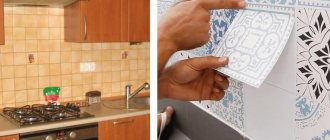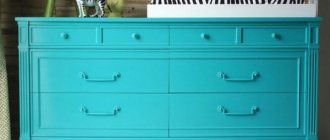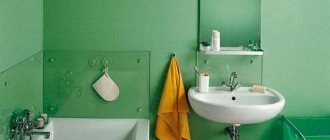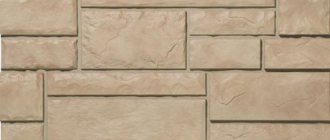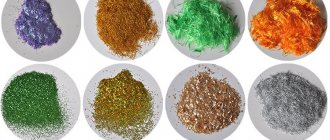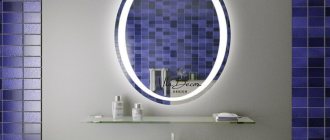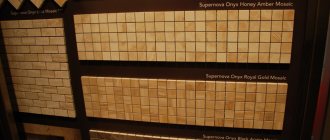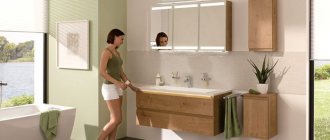There are many ways to decorate a bathroom, some expensive and some not so expensive. The simplest and most cost-effective option is painting, and if you use your imagination, it is also the most decorative. With just one paint you can completely change the style of the interior, make the room bright, exclusive, or vice versa, give it a strict but elegant look. No special skills are required for this, the main thing is to choose the right coloring technique. The process itself is also simple, but much depends on the quality of surface preparation and the choice of material.
Painting the walls in the bathroom
Benefits of coloring
So, why is painting better than other finishing options?
Inexpensive. Tiles, decorative plaster, plastic panels are still more expensive than paint. In addition to the main finishing, you will need related materials (tile adhesive, grout, slats for lathing under panels, etc.), as well as additional tools. To paint a bathroom, you will need paint, a primer, putty for leveling and painting supplies, which will cost several times less. Of course, tiles last longer, but even taking into account repainting after a few years, such repairs remain the most budget option.
Painted walls in the bathroom - an economical finishing option
Just. Tiling requires skill and a certain amount of skill. Without experience, it is difficult to lay it neatly and beautifully, especially in the corners. Sheathing with panels is simpler, but even there it is necessary to take accurate measurements, install the sheathing, and know how to properly attach the slats. When painting, the most crucial and difficult moment is preparing the surface and leveling it. To level the walls well, you need to try a lot, and not everyone succeeds perfectly the first time. But this is only if the surfaces are too uneven; with minor defects, everything works out perfectly even for beginners. Well, applying paint to even, smooth walls is no longer difficult.
Painting walls is the simplest and least labor-intensive process
Creative. Modern paints are distinguished not only by improved properties, but also by a huge variety of colors. Designers offer a lot of interesting combinations and methods of applying paint, which are much more decorative than any cladding. Combining colors and shades allows you to transform your interior beyond recognition at minimal cost. Various stencils and special rollers with textured patterns further simplify the painting process.
Stencils for decoration! Creating a unique interior
Textured rollers
Homemade textured roller
Practical. High-quality paints do not fade for a long time, are easy to clean from dirt, and if the application technology is followed, they do not crack or peel for years. Of course, such a coating can be easily damaged, for example, by catching something sharp or hitting a wall with a heavy object. But these defects can easily be eliminated with putty and tinting the damaged area; the main thing is to choose the paint according to the tone.
Touching up paint is much easier than replacing broken tiles
Color spectrum
The choice of colors is important for design, since color affects the perception of the interior, mood and mental state. It is important in advance, even at the stage of creating a design project, to decide what color is most appropriate to paint the walls in the bathroom. Since this room is most often used for a calm and relaxed pastime, it is better to choose a calm design in blue or green shades.
White is quite versatile and popular for decorating a bathroom, but don’t overdo it. In its pure form, snow-white creates the effect of a cold space, associated with not the most pleasant things, for example, a hospital. To avoid this effect in interior design, you should use a warmer shade of white - milky. And for variety, you can add accessories in bright colors; fortunately, white goes with any shade, so it’s impossible to make a mistake in choosing.
Black, burgundy or even red interior design can look original; it is important to choose the proportions correctly and dilute too aggressive colors with more neutral ones. Also, different colors can be used to zone a room or highlight individual elements. To highlight the shower area, a technique is often used with an accent wall in a contrasting color or with an ornament on a calm, plain background. You can see what colors to paint the walls in the bathroom in the interior photo and get design ideas from there.
Which paint to choose
The bathroom differs from other rooms in the apartment primarily due to its high humidity. This implies the use of finishing materials, including paint, with certain characteristics:
- moisture resistance;
- hygiene;
- antibacterial properties;
- ability to pass air;
- absence of harmful substances.
In addition, such paint must be resistant to abrasion, since the walls in the bathroom have to be washed and wiped very often. These requirements are partially met by oil paint and alkyd enamel, but water-soluble paint is most suitable. Let's consider the characteristics of each type separately.
How and what to paint bathroom walls with: 6 important recommendations
Oil paint
Now oil paints are not at all as popular as they were 10-15 years ago, but they still have a certain demand. Their main advantage is high adhesion and durability combined with a low price. Few modern paints can last this long without losing their visual appeal. The painted surface does not get wet, withstands repeated washing, and does not react with household chemicals.
Oil bath paint
The main components of oil paints are drying oil and pigments. Depending on the scope of application, various fillers are added to the composition: manganese and cobalt salts, talc, barite, mica. The paint is available for sale in two forms: liquid and paste (thickly rubbed). The first type is immediately ready for use, and the paint just needs to be thoroughly mixed until smooth. The second type requires diluting the composition with drying oil to the desired consistency. To thin the paint, you can also use kerosene, turpentine, and white spirit, but in small proportions - no more than 5% of the total mass.
Oil paints have a high density, which increases composition consumption. At the same time, this property helps to increase hiding power, and often one coat of paint is sufficient to obtain an even coating. Additionally, this structure allows you to mask minor flaws on the walls. It is recommended to apply it with a hard brush, rubbing it forcefully into the surface to be painted. To achieve the highest quality result, you need not only to carefully prepare the walls, but also to select the right paint for its intended purpose. Each type of surface (metal, wood, concrete, plaster, etc.) has its own composition, so carefully study the information on the packaging.
Oil paint Ditex MA-15
The disadvantage of oil paints is the long drying time. As a rule, this period is 5-7 days at a temperature of +20 degrees. At lower temperatures, paint takes even longer to dry. Some manufacturers are now adding special fillers to the composition, reducing drying time to 2-3 days. This information is also indicated on the packaging.
Alkyd enamel
Alkyd enamel
The water-repellent properties of the enamel allow this paint to be widely used in bathrooms. Painted surfaces do not become damp, can be easily cleaned with a variety of cleaning solutions, and do not fade or wear off for a long time. Two layers of paint, applied according to all the rules, retain their protective effect for 4 years. The enamel contains a solvent, so if necessary, the paint is diluted with turpentine, solvent, or white spirit in a ratio of 1:10 to the enamel weight.
For a high-quality coating, the application temperature range should be from 5 to 35°C, otherwise the adhesive properties are reduced. Each layer dries for 24 hours at 20°C; if the room is hot, the drying time is reduced. Typically, concrete, plaster and brick walls require 2-3 coats of paint to ensure the finish is as even as possible. Unlike oil paint, enamel is less viscous and therefore practically does not hide minor defects on the surface being painted.
Enamel is divided into glossy and matte. The main color spectrum is quite wide, in addition, the paint is perfectly mixed and tinted, and therefore choosing the desired shade will not be difficult. The pigments that make up modern enamels have increased resistance to ultraviolet radiation, and painted surfaces retain their rich color for a long time. When choosing, be sure to pay attention to the markings - universal enamel PF 115 is best suited for internal use.
Alkyd enamel PF-115
The main disadvantage of alkyd enamel is toxicity. The pungent, pungent odor takes a long time to dissipate from the room; a respirator is required during work. It is worth noting that only fresh paints are toxic; after drying and the smell disappears, there is no danger to human health. Another disadvantage is the flammability of paint, but many manufacturers add fire retardants to the composition, which reduce the risk of ignition to a minimum.
Main technical characteristics of PF-115
Consumption of PF-115 enamel for 1 and 2-layer coating
| Color PF-115 | Amount of enamel to obtain a coating of 1 micron, in g/m² | Thickness, 1 layer, microns | Thickness of 2 layers, microns | Approximate consumption, 2 layers, brush/roller, g/m2 |
| White | 3,75-3,17 | 18-23 | 40 | 130 |
| Black | 3,14,-2,65 | 13-18 | 30 | 80 |
| Green | 3,49-2,96 | 18-23 | 36 | 110 |
Enamel PF-115
Water-dispersion paint
The basis of this type of paint is an aqueous dispersion of polymers, mainly acrylic and vinyl acetate. They contain virtually no volatile organic solvents, making the paint non-toxic. After drying, a thin, very durable and elastic film is formed on the surface, which allows air to pass freely, but does not allow water to pass through. Depending on the composition, water-dispersion paints are divided into acrylic, silicone and PVA dispersions. PVA-based paints are rarely used for bathrooms, and only for ceilings, since they are not waterproof enough and cannot be washed.
Water-dispersion paint
Acrylic paint is the most popular:
- widest range of colors;
- high water-repellent properties;
- resistance to burnout;
- the ability to tighten small cracks and smooth out irregularities;
- Dries within an hour after application;
- good covering ability.
Antifungal components are often added to such paints, so the painted surface does not become moldy. Acrylic paint has a smell, but it is very weak and dissipates quickly.
Moisture-resistant paint for walls and ceilings
Silicone and silicate paints are superior to acrylic paints in many ways. They repel water and dirt better, are easier to clean, and are more resistant to abrasion. The film formed after application easily covers cracks up to 2 mm wide. Even after repeated washing, the surface retains its glossy shine, the colors remain as rich as on the first day. There is only one downside to such paints - high cost, although, compared to tiles, this option is still considered a budget option.
Silicone paint for walls and ceilings
Glossy or matte – which is better?
When choosing a paint, its dullness plays an important role. As you know, paints are divided into glossy, semi-matte and matte, which affects the appearance of the painted surface. Glossy ones perfectly reflect light, add shine to the surface and visually increase the space.
Which paint to choose – matte or glossy?
If you cover the ceiling with glossy paint, the bathroom will seem larger and lighter. In addition, the glossy finish is very smooth, which means it is much easier to clean. The disadvantage of these paints is that even the smallest flaws are clearly visible under the gloss. That is why glossy compounds are best used on perfectly smooth walls, for example, covered with plasterboard.
The combination of matte and glossy surfaces can become a design element
Combination of matte and glossy paint stripes
Matte paint, on the contrary, masks defects well, has a high covering ability, and can be applied even in one layer. Its surface is more porous, and therefore it is more difficult to remove dirt. In all other respects, it is in no way inferior to glossy. Semi-matte reflects light slightly and looks great on both ceilings and walls.
Matte painted walls
Textured paints
Textured paints differ from ordinary ones in their greater thickness and viscosity, due to the admixture of a large amount of filler. Such paints are applied in a thick layer, forming a relief surface. Depending on the application method, the relief layer may look completely different. The standard composition is white, so to make the walls colored, you need to additionally purchase a color scheme. The paint is tinted by simply mixing it with the selected pigment. It can be applied with a roller, brush, spatula and other tools convenient for you.
Textured paint for walls
Textured paints are water-soluble, so if necessary they can be diluted with water. They cannot be made too liquid, otherwise the composition will lose its decorative properties. The relief structure makes it possible to perfectly hide minor defects, but irregularities larger than 3-4 mm will already be visible. If the painting technology is followed, it lasts for several years, almost does not fade, and is not afraid of moisture and temperature changes.
Original pattern on green texture paint
It is worth noting that for textured wall decoration you will need a significant consumption of structural paint - about 500-1500 g/m2
As for the downsides: textured paint is more expensive than regular paint, it consumes a lot, and requires skill to apply. To learn how to evenly distribute the composition over the surface, you first need to practice a little on a separate piece of plywood. The easiest way is to use a wide roller.
How to buy quality paint
All efforts to paint a bathroom can be ruined by poor quality paint. Cracks, peeling, foreign impurities, swelling in the paint after drying - all this is the result of poor-quality composition or violation of storage conditions. Small manufacturers often produce paint and varnish products not in accordance with GOST, using cheap fillers and carcinogens. Trying to save money will only increase your costs since everything will have to be repainted.
Wall paints - how to choose and what to pay attention to
But even if the paint is of high quality, a lot depends on how it was stored. In stores and warehouses without heating, paint freezes in winter and almost completely loses its properties. This is especially true for water-based paints. To avoid such mistakes, you should buy paint exclusively in large hardware stores and supermarkets. All products there are certified, storage conditions are strictly observed, and there are no expired goods.
Appearance of paint
All compositions differ both in content and in appearance on the surface. After application, you can get different effects.
Glossy
The bathroom wall will have a shiny texture. The paint has good adhesion and is suitable for small spaces. Glitter can visually enlarge the space of the bathroom and make it brighter. Minus - the walls in the bathroom must be perfectly smooth and free of defects before painting.
Matte
Such a surface, on the contrary, can hide defects. Contamination is not so visible on it. It has good covering ability and can be applied in one layer. Due to the porous structure, maintenance is somewhat more difficult.
Textured
The main difference is thickness and viscosity. The composition contains a filler, thanks to which the coating acquires a three-dimensional pattern and becomes embossed. Textured paints can be called mini-decorative plaster. The after effect is amazing. This allows you to create different options for painting bathroom walls, making the room original and unusual. True, caring for the surface is not so easy.
What is better to paint
As you know, you can paint with a brush, roller or using a spray gun. If you have never had to make repairs yourself, it’s worth becoming more familiar with the pros and cons of each method in order to choose the best one.
| Tool | pros | Minuses |
Paint brushes | The brushes are inexpensive, a large assortment allows you to choose the most convenient width and stiffness of the bristles. The brush is convenient for painting corners and all hard-to-reach places | A lot of paint is consumed, hands get very tired during the work, painting speed is slow. Often traces of brush strokes remain on the surface |
Rollers | Affordable price, large selection of roller sizes and density, comfortable ergonomic shape. Paint consumption is significantly less than when using brushes. When working with a roller, much less time and physical effort is required; the paint is applied in an even thin layer over the entire surface. Special telescopic handles that are attached to the roller make it easy to paint walls under the ceiling | For painting, the surface must be as smooth as possible; the presence of flaws contributes to the low quality of the coating. Rollers are not suitable for painting in hard-to-reach places |
Spray guns | Quickly and very efficiently paints any surface, regardless of configuration. Uses paint very economically and does not require much physical effort | High cost, the need for thorough rinsing after each use. When using low-quality paint, the nozzle becomes clogged, and you have to disassemble and clean everything |
If you only need to paint the bathroom, and it has modest dimensions, it is not advisable to spend money on a spray gun. It is better to buy a roller and 1-2 narrow brushes to paint the corners.
Painting mistakes
To ensure a high-quality bathroom renovation, you need to avoid the following mistakes:
- Painting unprepared walls. The surface must be smooth, free of dust and lint, clean and level.
- Applying paint without a primer. This preparatory layer is necessary as it improves adhesion and paint consumption. In addition, the primer, if it contains an antiseptic, prevents the formation of fungus.
- Incorrect paint preparation. It is not made thick or too runny. There should be no lumps; the composition is mixed before application.
- Chaotic coloring. The direction of movement of the roller is either strictly vertical or horizontal. This way the surface will be painted evenly.
- Do not let the layer dry. This is incorrect; the paint will peel off the surface, sticking to the roller.
All that remains is to follow all the advice, choose the right paint and start applying it in the bathroom. Thanks to step-by-step instructions, everyone can do this quickly with their own hands.
Consumption of paint and additional materials
Before you begin the repair, you need to calculate the scope of work in advance and determine how much of which materials will be needed. The main cost item is paint; you will also need putty for leveling and a primer. In order not to overpay and run to the store if something is missing, calculate in advance the approximate consumption of these materials.
Putty is used to eliminate all irregularities greater than 2 mm. A few small defects are puttied separately, but if there are too many irregularities, a continuous application of at least 2 layers is required. For calculations, you need to know the rate of putty consumption per square meter, the area of all leveled surfaces and the thickness of the layer. The consumption rate is always indicated by the manufacturer on the packaging, and on average is 0.9-1.8 kg/m2. By multiplying the initial data, you will find out how much material you need to buy.
Putty walls for painting
Calculation example: the area of one wall is 3 × 4 m = 12 m2. The thickness of the leveling layer is 3 mm. The consumption rate is 1.2 kg/m2. Multiply 1.2 kg x 12 m2 x 3 mm = 43.2 kg. That is, for one wall you will need about 45 kg of putty (you need to buy with a small margin). The quantities for the remaining walls are calculated in the same way and then summed up.
The surfaces are primed twice - before applying putty and after leveling. This helps to increase water-repellent properties and more uniform paint application. The average consumption rate of the primer mixture is 0.1-0.15 kg/m2. The amount of primer is calculated in the same way as putty: multiply the area by the consumption rate and the number of layers.
Primer for walls
Paint consumption rates differ depending on its composition and covering ability.
| Type of paint | Consumption rate g/m2 | Number of layers |
| Oily | 140-250 | 1-2 |
| Alkyd enamel | 110-130 | 2 |
| Acrylic | 115-250 | 2-3 |
| Latex | 500-600 | 2 |
| Silicone | 250-300 | 2 |
| Silicate | 350-400 | 2 |
| Textured | 800-1000 | 1 |
The data given in the table may differ slightly from actual consumption rates. This depends on the porosity of the substrate and the method of applying the paint. As in previous cases, the calculations use the area of the surface to be painted and the number of layers, which are multiplied by the specified consumption rate.
Consumption also depends on color
Preparatory work
The stage of preparing bathroom walls for painting is very important; the quality and durability of the repair itself depends on it. You can prepare the foundation yourself or hire specialists. How to prepare and paint the walls in the bathroom at home can be seen in the photo below.
Dismantling the old coating
Having decided what paint to paint the walls in the bathroom, it’s time to start preparing the base. The first step is to remove the tiles or remove the old paint. You can almost easily handle this with your own hands. To remove the old paint layer, sometimes a hard spatula is enough. If in some places the old coating is too strong, you can sand it and leave it that way.
Applying putty
This is an intermediate stage of preparatory work to prepare the walls for painting. When choosing a putty, you should take into account the high humidity of the room; it is better to choose a latex-based water-based mixture. This putty is specially designed for use in damp rooms, so it will do the job perfectly.
The method of applying putty to the walls is the same as for plaster - using a spatula in an even layer. The solution is applied from bottom to top. The first step is to cover the most uneven places, and then level the rest.
Base primer
Like putty, primer for walls to be painted in the bathroom should also be waterproof. The choice of primer depends only on you, since most primers are universal; the average price for a primer in stores is 200 rubles. Before applying, be sure to read the instructions on the can and also take into account the drying time. You can start painting 24 hours after priming the walls.
Important! The primer should be applied in at least two layers.
The process of priming the surface before painting the walls in the bathroom can be seen in the photo below.
Preparing the bathroom for painting
The preparatory process includes two stages - removing the old finish and leveling the surfaces. In some cases, it is not necessary to remove the coating to the base, for example, if the walls have already been painted and have no defects. Then the surface is simply cleaned of dust and dirt, primed and dried before applying new paint. But this happens very rarely, and you can almost always find peeling areas, cracks, potholes, and areas infected with fungus.
Step 1. First, take out everything unnecessary from the bathroom, remove the baseboards and old lining (if any). Peeled paint can be easily removed with a scraper or spatula by prying up its edges. Where the paint sits tightly, it is best to use a grinder with a flexible disc for sanding.
How to remove paint from a wall
Video: Removing, removing old paint from walls.
Step 2. Small potholes and cracks are rubbed with sandpaper.
Sanding walls
Large cracks are expanded for subsequent sealing with mortar.
Joining cracks
The whitewash is simply washed off with water to a solid base.
You can wash off whitewash from walls using a regular sponge and water.
Step 3. Areas blackened by mold are treated separately: thoroughly cleaned with a scraper, wiped and any antiseptic composition is applied. Particularly carefully inspect the places behind the pipes, where dirt most often accumulates and fungus develops.
Means for eliminating fungus and mold
Step 4. After the walls are cleaned, you need to remove all debris, dust and dirt. Large cracks in the walls are filled with plaster mortar and allowed to dry.
Sealing cracks and crevices in walls
Step 5. Next, prime the surfaces, starting from the top. In dry rooms, you can prime it once, directly before painting, but for the bathroom more reliable protection is needed. Be sure to use a deep-penetrating, water-resistant primer. To apply the primer, use a fine-nap roller. Foam rubber is not quite a suitable option for these purposes.
Deep penetration primer
The primer composition is poured into a paint bath, the roller is dipped and rolled evenly over the surface. Where the roller does not reach, prime with a brush. Make sure there are no dry areas or drips. Depending on the composition, the primer dries from 4 to 12 hours. If the base of the walls is quite porous, it is advisable to prime again after the first layer has completely dried. For a strong concrete surface, once is enough.
Wall primer
Step 6. According to the instructions indicated on the package, dilute the putty mixture with water and fill all the uneven areas. The mixture is applied with a spatula and excess putty is removed with it. If you need to level the surface with a continuous layer, take a wide spatula, apply the solution along the entire length of the blade and, holding the spatula at an angle to the wall, apply the putty with an even movement. There is no need to press hard on the spatula, the main thing is that the blade fits snugly to the surface. Movements are performed from the bottom up, making sure that there are no sagging or voids left.
Wall putty - photo
Step 7. When the putty has dried, the walls are thoroughly sanded with fine-grained sandpaper. This will help give the surface the required smoothness. Since a lot of dust is generated during the grinding process, upon completion of the work, wipe everything with a damp, clean cloth.
Step 8. The prepared surface is primed a second time, again starting from the top. After this, all that remains is to wait for the composition to dry.
Pros and cons of painting walls
Finishing walls with paint is a cheaper option compared to tiles, plastic panels or decorative plasters, but has no worse properties.
The positive characteristics of painting walls are:
- Budget savings. Paints are cheaper in price than other types of finishes, so painting your bathroom won't break your budget as much.
- Easy to apply. Coloring is done easily and without any special skills.
- Assortment of colors. The variety of palettes can bring any designer's ideas to life.
In addition to the listed advantages, it is worth adding that good paint, when applied correctly, will create a room that will meet sanitary hygiene standards.
Negative qualities of the painted surface include:
- Frequent cleaning. Every day after bathing, the walls must be wiped.
- Condensate. It occurs when a small bathroom has poor ventilation and therefore destroys the finish. In this case, you often have to renovate the bathroom.
- High probability of damage to the coating. You can easily scratch it with a sharp object, ruining the finish, and moisture will collect underneath it.
Painting the bathroom
The easiest way to paint a bathroom is one color. To avoid accidentally staining the ceiling and other areas that are not to be painted, apply masking tape along the boundaries of these areas. This must be done carefully, checking the evenness of the lines, otherwise you will have to eliminate errors later.
Step 1. Mix the paint thoroughly until smooth. If a film has formed on the surface of the paint, it must be removed very carefully, otherwise small pieces of film will fall on the walls and the whole look will be ruined.
Mixing paint with color
Step 2. As a rule, colored compounds are used for walls, not white, so you need to tint the paint correctly. This applies mainly to water-dispersion paints, since enamels and oil paints are sold already tinted. Pour a little color from a bottle into a bucket of paint in a thin stream and mix with a mixer at the lowest speed. When the composition acquires a uniform color, add a little more color and stir. This way you can more accurately select the desired shade. If you immediately pour out all the color from the bottle, the color of the paint may turn out to be darker than required.
Color for paint
Advice. To ensure that the walls do not differ in tone, a volume of paint is tinted that is enough for the entire area. If you dilute the composition for each wall separately, it is unlikely that you will be able to choose exactly the same color.
Step 3. First paint the joints in the corners, at the doorway and hard-to-reach areas using a narrow brush. Rub the paint thoroughly, removing drips and sagging. Brush movements should be in one direction.
Step 4. Take a wide brush or roller and start painting the walls themselves. Do not dip the tool into the paint too much, as this will cause drips and splashes. If a roller is used, roll it well over the embossed surface of the tray so that the paint evenly saturates the material. Paint the walls in parallel stripes, from top to bottom, rolling the roller until the base stops showing through. In this way, paint the entire area and leave the walls to dry.
How to paint walls correctly
Advice. While the walls are drying, the roller should be placed in a plastic bag and wrapped tightly. This will keep it from drying out and you can use it to apply a second coat. Do the same with a paint brush.
Step 5. After drying, the entire procedure is repeated again in the same sequence. When the walls are completely painted, very carefully remove the masking tape. This can be done after some time, but preferably before the second layer of paint has completely dried.
Usually two layers are enough, but sometimes one more is needed. This can be determined visually: if the walls have an uneven tone, certain areas are visible, traces of brush strokes are visible, then a third layer is necessary. If the color of the walls is deep and even, there are no visible flaws, there is no need to paint anymore.
Applying the first and second coats of paint
Water emulsions
Water-based paint for bathrooms is a justified choice. You get good results at a low price. Advantages:
- environmentally friendly material is harmless to health;
- has no unpleasant odor;
- the coating dries quickly;
- working with water-based emulsion is very easy even for a beginner;
- it is possible to experiment with shades, mixing and adding any colors as desired;
- due to its low cost and ease of use, you can renew indoor walls using water-based paint at least every year;
- the composition of decorative paint will allow you to implement different design solutions by applying graphic ornaments or designs to the surface using stencils and other devices.
The material can be intended for finishing dry or wet rooms; you need to pay attention to this when purchasing. The coating can also be matte or glossy. The first visually expands the space and smoothes out small blemishes on the painted surface, while the second, on the contrary, emphasizes all the irregularities, but gives a slight mirror effect and is more resistant to abrasion.
Water-based bathroom paint also has disadvantages. For example, the coating will not last long if it is washed frequently using even gentle products (laundry soap).
However, on modern shelves you can also find water-based paints that contain special components that increase the durability of the coating. These paints can protect and decorate walls for 5 to 10 years.
Painting can be combined with tiles and other materials
Decorative painting methods
Unfortunately, not everyone knows how to draw, so only a few can decorate bathroom walls with hand-painted paintings. Hiring a specialist for this is too expensive, which means you need to look for simpler ways. A wide palette of modern colors provides a wonderful opportunity to decorate the interior without much effort.
Using stencils
This is one of the most popular methods. Nowadays there are many ready-made stencils for painting that are inexpensive and easy to use. Disposable stencils are made of vinyl film on an adhesive base; acrylic and durable plastic are used to make reusable templates. Such stencils are tightly fixed to the wall, which makes applying the design as simple as possible.
Step 1. Paint the walls as described above, wait until completely dry. Select a suitable pattern and determine its location.
Step 2 . Remove the protective film from the stencil and carefully attach it to the wall surface. If there is no self-adhesive layer, the stencil is secured with masking tape on all sides.
Attach the stencil to the wall
Step 3. The roller is dipped in paint, rolled first over the tray to remove excess, then over the surface of the stencil. All cutouts must be evenly covered with paint, otherwise the pattern will not be clear.
Paint over the stencil. Use a roller or brush
Move the stencil and continue applying the design to the walls
Step 4. Carefully unfasten the template from the wall and allow the pattern to dry.
Stencil painting
The color of the pattern should go well with the main color and stand out against the background of the walls. Incorrectly selected shades can ruin everything, and the original idea will lose all its charm.
Video: Drawings on walls using stencils
Striped walls
With the help of a simple multi-colored strip on the walls, you can give the bathroom a special charm and visually expand the boundaries of the interior. There are a huge number of options here, so it all depends on your imagination. You can experiment with the width and location of the stripes, the number of colors and shades. Stripes of the same color, but with different surfaces - matte and glossy - look interesting.
Paint the walls striped
Bathroom interior with striped walls
Design project for a bathroom with striped walls
To choose the best option, it is best to draw a diagram of the stripes on paper and color them to your liking.
Next, all that remains is to buy the paint of the desired color and several rolls of masking tape. The walls should already be painted in the base color.
Step 1. Work begins from one of the corners of the bathroom. Using a building level, draw a vertical line along the wall from ceiling to floor with a simple pencil. Measure the selected strip width and draw a second line. The remaining stripes are marked in the same way up to the corner.
Step 2. Apply masking tape strictly along the lines. In this case, the tape should be inside those stripes that will remain in the base color. Lines drawn with a pencil cannot be glued, because this way they will be visible on the painted surface.
The adhesive tape is smoothed well so that there is no air left under it, otherwise the paint will get inside and the stripes will be sloppy. Additionally, the joints between the ceiling and walls are covered.
Step 3. Pour paint into the tray, dip the roller into it and begin to roll it along the first stripe. The layer should be applied evenly, without smudges. Having painted one strip, move on to the next, observing the alternation of stripes by color. If necessary, apply a second coat of paint, waiting for the first to dry.
Apply masking tape
Striped wall painting scheme
Painting a wall with a roller
Step 4 . After painting is completed, carefully remove the tape from the wall. This should be done slowly, with smooth movements, as a sharp tear can lead to peeling of the paint.
Peel off the tape
In the same way, you can make horizontal and diagonal stripes, as well as more complex patterns. If you apply masking tape in perpendicular lines and then paint over individual areas, you will get colored squares.
Creative on the walls
The most important thing in this type of painting is extreme accuracy at every stage. Paint easily penetrates under poorly secured tape, smears lines, and leaves smudges. All this will have to be wiped off and re-painted.
Rollers for applications
This is probably the fastest and most convenient way to decorate. A special patterned roller has two attachments - a foam rubber one, which absorbs paint, and a rubber one, with an embossed pattern for imprinting.
Patterned roller with animal images
First, the walls are prepared in the standard way and painted in the base color. To apply the pattern, choose a paint that is contrasting in color and harmonizes with the main one. Next, paint is poured, the roller is dipped so that the foam nozzle is well saturated, and both nozzles are rolled out together over the tray.
How to paint a wall with a pattern roller
The most crucial moment here is applying the pattern. The roller must be guided evenly, from top to bottom, strictly vertically. The next strip should run parallel to the first, exactly along the border of the pattern. If the edges of the strips overlap each other, it will look sloppy, and to fix this, you need to completely repaint the wall.
Paint on bathroom walls: benefits of finishing
The first advantage is the money saved: painting the walls will still be cheaper than covering them with ceramics. High-quality paint will remain in its original form for years, decorating the bathroom with its color. By the way, if you think about buying high-quality tiles with a pattern, the cost of the material and all the work will be much higher.
However, it is advisable to purchase a coloring composition that is more expensive than the average price segment, in this case the result will be guaranteed to be durable and beautiful.
Myths about the inadvisability of painting bathroom walls do not stand up to scrutiny when examined in more detail. Today, manufacturers who care about their good name produce quality products. This composition is non-toxic, completely safe for health and retains its characteristics for a long time.
Mold and mildew only bother painted walls when there are poor ventilation, high humidity and clutter.
Another obvious advantage of painting walls will be their decorativeness, originality, and different design from others. This finish wins compared to PVC panels, since the walls receive additional protection.
Painting is not a complicated process, it does not require special skills, all pitfalls can be easily avoided if you read the instructions and tips on painting.
Silicone water dispersion
Silicone paint, as well as latex and acrylic, are water-based compositions. This means that it is also odorless and applies well. However, it has its own characteristics. Here are its advantages:
- Good adhesion. Can be applied to concrete, putty, brick, wood, stone, etc.
- Does not require an ideal surface, hides roughness and small cracks.
- Can be used at high and low temperatures.
- The film repels water, but allows steam and gas to pass through. That is, walls or ceilings coated with silicone paint “breathe.”
- Prevents the development of fungi and microorganisms.
- Easy to clean.
- Tolerates exposure to sunlight well.
- Long service life (up to 25 years).
If you need paint for your bathroom so that the walls and ceiling “breathe”, choose silicone paint. It is good in problem areas where there is mold or mildew.
Silicone bathroom paints are a good choice
There are also disadvantages:
- Price. Not the cheapest paint. But looking at the service life, you understand that the costs are justified.
- It is not advisable to use this paint on metal: it is vapor-permeable, which causes the metal to quickly rust. When painting reinforced concrete, measures are required to protect the reinforcement - impregnation with anti-corrosion compounds.
Silicone paint is applied like any water-based paint, with a roller or brush. To reduce the consumption of an expensive composition, it is advisable to pre-prime the surface. The primer should also be silicone based. Work begins at above-zero temperatures (usually above +5°C) and normal humidity. The composition must be applied to clean, dry walls or ceilings.
